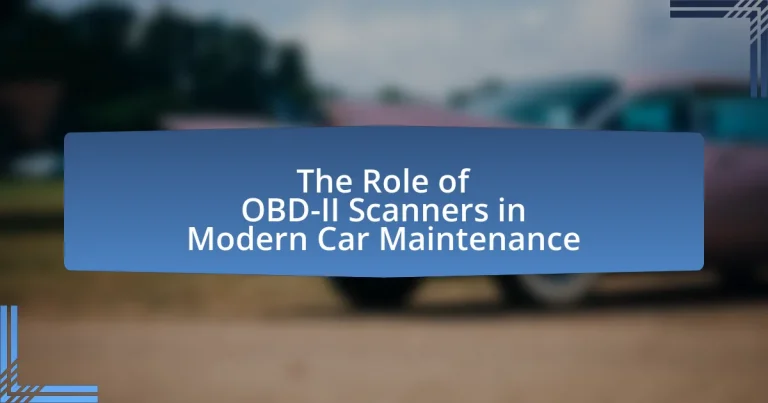OBD-II scanners are essential tools in modern car maintenance, providing real-time diagnostic information about vehicle performance and health. These devices connect to a vehicle’s onboard diagnostics system, enabling the reading of trouble codes and monitoring of engine parameters, which helps identify issues early and reduce repair costs. The article explores how OBD-II scanners function, their key components, and the benefits they offer, including enhanced diagnostic accuracy and preventive maintenance. Additionally, it addresses the limitations of OBD-II scanners, the types of issues they cannot diagnose, and best practices for their effective use in maintaining vehicle longevity and efficiency.

What is the Role of OBD-II Scanners in Modern Car Maintenance?
OBD-II scanners play a crucial role in modern car maintenance by providing real-time diagnostic information about a vehicle’s performance and health. These devices connect to the vehicle’s onboard diagnostics system, allowing mechanics and car owners to read trouble codes, monitor engine parameters, and identify issues before they escalate. For instance, according to the National Highway Traffic Safety Administration, OBD-II systems have been mandatory in vehicles since 1996, ensuring standardized access to diagnostic data. This capability enables timely maintenance, reduces repair costs, and enhances vehicle safety by addressing problems early.
How do OBD-II Scanners function in vehicles?
OBD-II scanners function by connecting to a vehicle’s onboard diagnostics system to retrieve and interpret diagnostic trouble codes (DTCs) and real-time data. These scanners communicate with the vehicle’s Engine Control Unit (ECU) through a standardized 16-pin connector, allowing them to access information about various systems, including the engine, transmission, and emissions controls. The OBD-II protocol, established in the mid-1990s, ensures that all vehicles manufactured after 1996 are equipped with this diagnostic capability, enabling mechanics and technicians to quickly identify issues and monitor vehicle performance.
What are the key components of an OBD-II Scanner?
The key components of an OBD-II scanner include the diagnostic connector, microcontroller, software interface, and communication protocols. The diagnostic connector, typically a 16-pin interface, allows the scanner to connect to the vehicle’s onboard computer. The microcontroller processes data and executes commands, while the software interface provides a user-friendly way to interpret diagnostic trouble codes (DTCs) and vehicle data. Communication protocols, such as ISO 9141, ISO 14230, and CAN, enable the scanner to communicate effectively with the vehicle’s systems. These components work together to facilitate vehicle diagnostics and maintenance, ensuring compliance with OBD-II standards established in the 1990s for emissions control.
How do OBD-II Scanners communicate with a vehicle’s systems?
OBD-II scanners communicate with a vehicle’s systems through a standardized protocol that utilizes the On-Board Diagnostics II interface. This interface allows the scanner to connect to the vehicle’s Engine Control Unit (ECU) via a 16-pin connector, enabling the exchange of diagnostic information. The communication occurs through various protocols such as ISO 9141, ISO 14230 (Keyword Protocol 2000), and ISO 15765 (CAN bus), which define how data is transmitted and received. These protocols facilitate the retrieval of trouble codes, sensor data, and other vehicle performance metrics, ensuring accurate diagnostics and maintenance.
What are the primary benefits of using OBD-II Scanners?
The primary benefits of using OBD-II scanners include enhanced diagnostic capabilities, improved vehicle maintenance, and cost savings. OBD-II scanners provide real-time data from the vehicle’s onboard computer, allowing for accurate identification of issues, which leads to timely repairs. According to the U.S. Department of Transportation, the use of OBD-II systems has significantly reduced vehicle emissions by enabling quicker detection of malfunctions. Additionally, regular use of OBD-II scanners can help prevent costly repairs by identifying problems early, ultimately saving vehicle owners money on maintenance.
How do OBD-II Scanners enhance diagnostic accuracy?
OBD-II scanners enhance diagnostic accuracy by providing real-time data and standardized trouble codes from a vehicle’s onboard computer system. These scanners interface directly with the vehicle’s electronic control unit (ECU), allowing technicians to quickly identify specific issues based on diagnostic trouble codes (DTCs) that are universally recognized across different vehicle makes and models. For instance, a study by the National Institute for Automotive Service Excellence found that using OBD-II scanners can reduce diagnostic time by up to 30%, leading to more precise repairs and improved vehicle performance. This efficiency is crucial in modern car maintenance, as it minimizes guesswork and ensures that technicians can address the root cause of problems effectively.
What cost savings can be achieved through OBD-II Scanner usage?
OBD-II scanners can achieve significant cost savings by enabling early detection of vehicle issues, which prevents costly repairs. By identifying problems before they escalate, vehicle owners can save an average of $1,000 in repair costs annually, as reported by the Automotive Service Association. Additionally, OBD-II scanners facilitate DIY diagnostics, reducing the need for professional mechanic services, which can cost between $100 to $200 per hour. This proactive approach to vehicle maintenance not only minimizes repair expenses but also enhances fuel efficiency, leading to further savings on fuel costs.

How do OBD-II Scanners contribute to preventive maintenance?
OBD-II scanners contribute to preventive maintenance by providing real-time diagnostic information about a vehicle’s performance and potential issues. These scanners read trouble codes generated by the vehicle’s onboard computer, allowing technicians and vehicle owners to identify problems before they escalate into major repairs. For instance, according to the National Highway Traffic Safety Administration, early detection of issues through OBD-II diagnostics can lead to a reduction in repair costs by up to 30%. By regularly using OBD-II scanners, vehicle owners can maintain optimal performance, enhance fuel efficiency, and extend the lifespan of their vehicles.
What types of issues can OBD-II Scanners detect early?
OBD-II scanners can detect early issues such as engine misfires, fuel system problems, and emissions control failures. These scanners monitor various vehicle systems and can identify trouble codes that indicate specific malfunctions. For instance, a misfire can lead to increased emissions and reduced fuel efficiency, while fuel system issues can affect engine performance and drivability. Emissions control failures can trigger the check engine light, signaling potential compliance issues with environmental regulations. By providing diagnostic trouble codes, OBD-II scanners enable timely maintenance, helping to prevent more severe damage and costly repairs.
How does early detection impact vehicle longevity?
Early detection of vehicle issues significantly enhances vehicle longevity by allowing for timely repairs before minor problems escalate into major failures. For instance, regular diagnostics using OBD-II scanners can identify engine misfires or transmission issues early, which, if left unaddressed, could lead to costly repairs or even total engine failure. Studies indicate that vehicles maintained with proactive diagnostics can last up to 50% longer than those that are not regularly checked, as early intervention minimizes wear and tear on critical components.
What are common warning signs identified by OBD-II Scanners?
Common warning signs identified by OBD-II scanners include the check engine light, diagnostic trouble codes (DTCs), and issues with the vehicle’s emissions system. The check engine light indicates a range of potential problems, while DTCs provide specific codes that help diagnose issues such as misfires, sensor failures, or fuel system malfunctions. Additionally, OBD-II scanners can detect emissions-related problems, which are crucial for meeting environmental regulations. These indicators are essential for timely maintenance and repairs, ensuring vehicle safety and efficiency.
How can OBD-II Scanners improve repair efficiency?
OBD-II scanners improve repair efficiency by providing real-time diagnostic data that helps technicians quickly identify vehicle issues. These scanners read trouble codes generated by the vehicle’s onboard computer, allowing for faster troubleshooting and targeted repairs. For instance, a study by the Automotive Service Association found that using OBD-II scanners can reduce diagnostic time by up to 30%, leading to quicker turnaround times for repairs. This efficiency not only saves labor costs but also enhances customer satisfaction by minimizing vehicle downtime.
What role do OBD-II Scanners play in troubleshooting?
OBD-II scanners play a crucial role in troubleshooting vehicle issues by providing diagnostic information directly from the car’s onboard computer system. These scanners read trouble codes generated by the vehicle’s Engine Control Unit (ECU), which indicate specific malfunctions or performance issues. For instance, when a check engine light activates, the OBD-II scanner can identify the corresponding code, such as P0420 for a catalytic converter efficiency problem, allowing technicians to pinpoint the exact issue quickly. This capability enhances the efficiency of repairs and maintenance, as it reduces the time spent on diagnostics and helps ensure that the correct repairs are made based on accurate data.
How do OBD-II Scanners streamline the repair process?
OBD-II scanners streamline the repair process by providing real-time diagnostic data and trouble codes from a vehicle’s onboard computer system. These scanners enable technicians to quickly identify issues, reducing the time spent on troubleshooting. For instance, OBD-II scanners can retrieve specific error codes that indicate the exact malfunctioning component, allowing for targeted repairs rather than guesswork. According to the Automotive Service Association, using OBD-II technology can decrease diagnostic time by up to 30%, leading to faster repairs and improved customer satisfaction.

What are the limitations of OBD-II Scanners in car maintenance?
OBD-II scanners have several limitations in car maintenance, primarily their inability to diagnose all vehicle issues. While OBD-II scanners can read diagnostic trouble codes (DTCs) and provide information on emissions-related problems, they often do not cover non-emission-related issues, such as mechanical failures or electrical problems. Additionally, OBD-II scanners may not be compatible with all vehicle makes and models, leading to incomplete data retrieval. Furthermore, these scanners typically provide generic codes that may not offer specific details about the underlying problem, requiring further investigation by a technician. Lastly, OBD-II scanners do not perform real-time monitoring of all vehicle systems, limiting their effectiveness in diagnosing intermittent issues.
What types of problems can OBD-II Scanners not diagnose?
OBD-II scanners cannot diagnose problems related to mechanical failures, electrical issues outside of the engine control unit, or non-emission-related faults. These scanners primarily focus on monitoring and reporting data from the vehicle’s onboard diagnostics system, which is designed to identify issues related to emissions and engine performance. For instance, OBD-II scanners will not detect problems such as a faulty transmission, brake system failures, or issues with the vehicle’s suspension. This limitation is due to the fact that OBD-II systems are specifically tailored to monitor emissions-related components and engine performance parameters, rather than providing a comprehensive overview of all vehicle systems.
How can users supplement OBD-II Scanner data for comprehensive diagnostics?
Users can supplement OBD-II Scanner data for comprehensive diagnostics by integrating additional diagnostic tools and resources, such as manufacturer-specific repair manuals, online automotive forums, and advanced diagnostic software. These resources provide detailed information on vehicle-specific issues that may not be captured by standard OBD-II codes, allowing users to interpret data more accurately and identify underlying problems. For instance, manufacturer-specific manuals often include troubleshooting steps and repair procedures tailored to particular vehicle models, enhancing the diagnostic process. Additionally, advanced diagnostic software can analyze live data streams and perform more in-depth assessments, leading to a more thorough understanding of vehicle health.
What are the best practices for using OBD-II Scanners?
The best practices for using OBD-II scanners include ensuring compatibility with the vehicle, connecting the scanner properly, and interpreting the diagnostic trouble codes accurately. First, users should verify that the OBD-II scanner is compatible with their vehicle’s make and model, as not all scanners support every vehicle. Next, the scanner must be connected to the OBD-II port, typically located under the dashboard, ensuring a secure connection to avoid data transmission errors. Finally, users should accurately interpret the diagnostic trouble codes (DTCs) provided by the scanner, referencing the vehicle’s service manual or reliable online databases to understand the specific issues indicated by the codes. Following these practices enhances the effectiveness of the diagnostic process and aids in proper vehicle maintenance.
How often should OBD-II Scanners be used for optimal maintenance?
OBD-II scanners should be used at least once every six months for optimal maintenance. Regular usage helps identify potential issues before they escalate, ensuring the vehicle operates efficiently. According to the Automotive Service Association, scanning a vehicle regularly can lead to early detection of problems, which can save drivers significant repair costs and enhance vehicle longevity.
What tips can enhance the effectiveness of OBD-II Scanner readings?
To enhance the effectiveness of OBD-II scanner readings, ensure that the vehicle’s ignition is in the “On” position without starting the engine. This allows the scanner to communicate effectively with the vehicle’s onboard computer. Additionally, using a high-quality scanner compatible with the vehicle’s make and model can provide more accurate and comprehensive data. Regularly updating the scanner’s software ensures access to the latest diagnostic trouble codes and fixes. Furthermore, clearing old codes after repairs and re-scanning can confirm that issues have been resolved, leading to more reliable readings. These practices are supported by automotive diagnostic standards, which emphasize the importance of proper setup and tool compatibility for accurate diagnostics.


